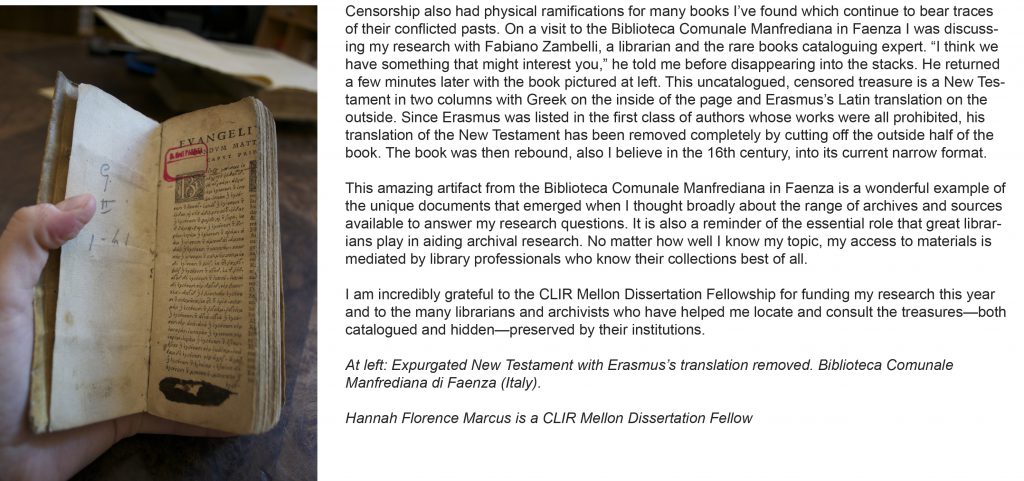By Hannah Florence Marcus
As I enter into the final months of my CLIR fellowship, it is a treat to reflect on the diversity of archival experiences I’ve had in the past nine months. My dissertation, titled “Heterodox Healers: Censorship and Medical Scholarship in Late Renaissance Italy, 1559-1664,” has propelled me into the archives of Italy and the Vatican. So far this year I have visited 16 different libraries and archives on the Italian peninsula. I’ve navigated the high-tech registration systems at the Vatican Library (think Dan Brown) and then crossed the Tiber in the afternoon and climbed the stairs to the pristine reading room of the Angelica Library (where the library scenes in Angles and Demons were actually filmed). In Imola, I sat in a side room in the bishop’s palace reading inquisition trials while the archivist held office hours across the table. Every Wednesday morning in Rome I would hear Pope Francis’s sermons through the window while I worked at the Archive of the Congregation for Doctrine of the Faith next to Saint Peter’s Cathedral.
My research tells the story of physicians in the sixteenth and seventeenth centuries who worked with, against, and in spite of the rules laid down by the Roman Inquisition and the Index of Prohibited Books to read and own banned texts. The different purposes and cross purposes of “my physicians” has lead me to search for clues and answers in the official records of the Inquisition and Index, in the personal papers of early modern scholars, and in banned books themselves, which are treasure troves of information about how censorship laws were enacted and ignored at the level of individual readers and censors.
My visits to the archives have been characterized both by serendipitous moments of success and discovery and also by frustrations and setbacks. Upon arriving at the Vatican Library in the fall I learned that two whole collections of books, including the books that were part of the Roman Inquisition’s private library, were closed for the entire year for “cleaning and fumigation.” I was surprised and delighted to find that the analogous library of the Congregation of the Index of Prohibited Books was housed at the Casanatense Library around the corner from the Pantheon. I had a wonderful time working there for nearly a month, but when I returned to the collection a few months later to consult additional materials, I learned that during the winter’s intense rains part of the ceiling had collapsed in the room where they store the old books and manuscripts. The Fire Department ordered the room closed until its safety could be officially verified. Four months later the collections are still unavailable. I have to keep reminding myself that neither Rome nor my dissertation was or will be built in a day, or even a year for that matter.
However, the joys of archival research have far outweighed the frustrations—it’s hard to beat the rush of finding a four-hundred-year-old document that explicitly confirms a historical hunch. The sources can also be quite amusing. After investing in a printing press in the Vatican, the official in charge of finances reminded the enthusiastic Congregation of Rites that the expense was only justified if it was used regularly: “You don’t buy a printing press to only print one book only one time.” Another letter from a Renaissance doctor, aspiring naturalist, and censor for the Roman Inquisition left me smirking in the reading room when his account of a beached whale remarked explicitly on its “extremely huge genital member.” I can only hope that another censor was joking when his report on a bad and lascivious book suggested that the book should be burned and that “if the author were still alive he should be burned too.” It is certainly a sobering reminder that censorship had very real personal, social, and even physical ramifications in its own day.


